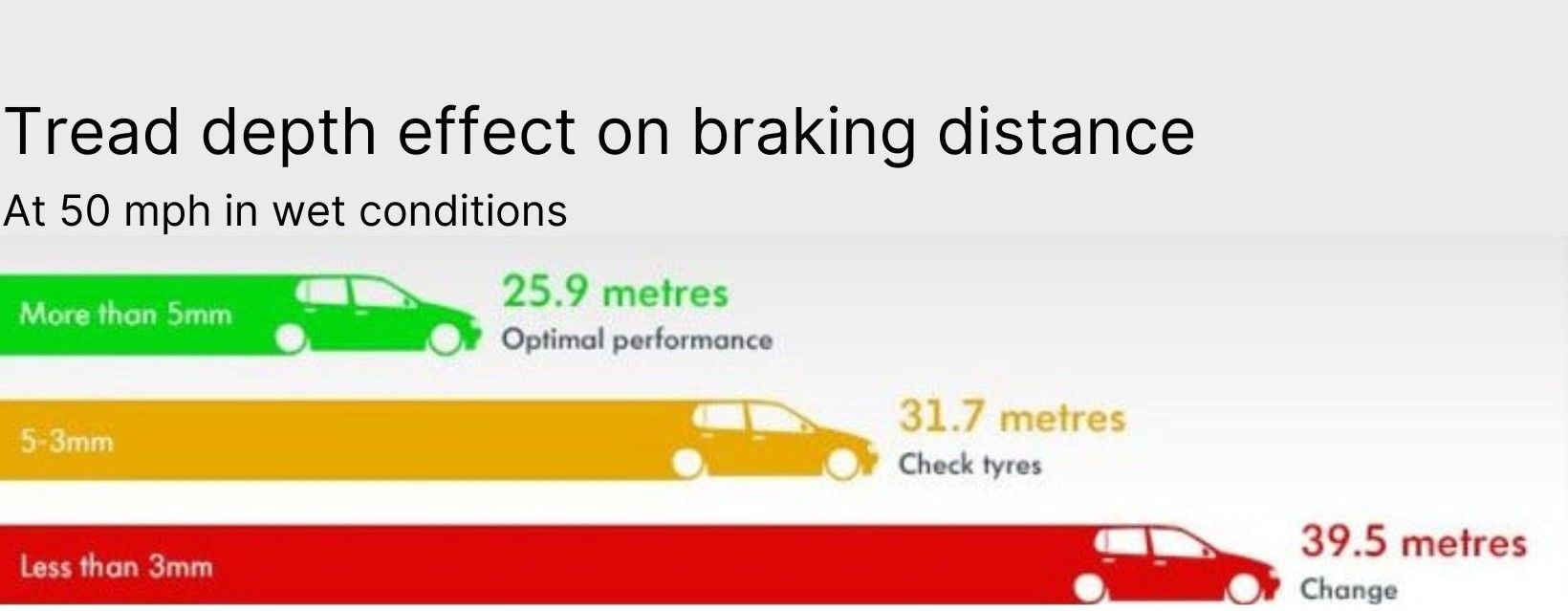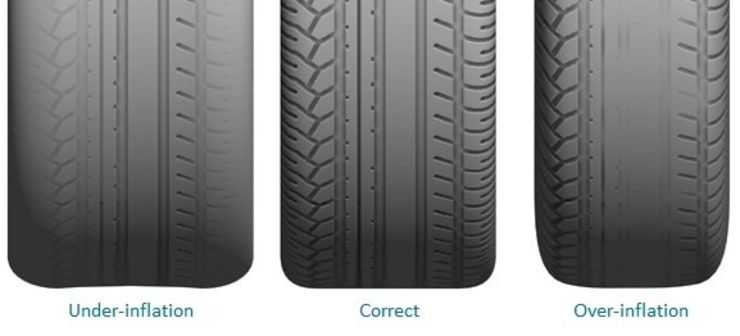Check The Tread Depth
A quick and easy way to check that your tyre tread depth is legal (1.6mm throughout a continuous band comprising the central three-quarters of breadth of the tread and around its entire outer circumference) is to take the 20p test. Simply place a 20p coin into the main tread grooves of your tyre. If the outer band of the 20p coin is obscured when it’s inserted, then your tread depth is above the legal limit. If the outer band of the coin is visible, then your tyres may be illegal and more importantly, unsafe. When taking the test, remember to check at least three locations around each tyre. The test is quick and easy and will help you and your passengers stay safe.
But it’s best to have your tyres changed every 20,000 to 30,000 or up to 10 years to maintain the safety of your car. If your tyres are damaged or worn they should be changed earlier.

Remember, driving on wet roads in a vehicles with tyres of insufficient tread depth can cause aquaplaning; this is where your tyres lose contact with the road surface, instead travelling on top of the water surface. This makes it impossible for you to accelerate, steer or brake effectively, in short, an accident waiting to happen.

Check the tyre pressure
Just by checking your tyre pressures weekly you’ll benefit from lower fuel bills, longer tyre life, increased safety and reduced CO2 emissions, make sure you check your tyre pressures at least once a month and before a long journey.
Correct tyre pressure is vital to your safety on the road. Under-inflated tyres affect handling and grip, causing irregular and unpredictable handling; they’re also much more likely to suffer from a dangerous and sudden rapid deflation, especially on high-speed motorway journeys. Keeping your tyres at their optimum pressure, will also reduce your running costs, as under-inflated tyres need more force to make them turn, meaning your vehicle uses more fuel; not only this, tyres set at the incorrect pressure wear out more quickly, meaning unnecessary and costly replacement.
To find out the recommended pressure for your tyres, look in the owner's manual. If you’re unsure or would like more personalised advice, then please get in contact with your nearest dealership.
Problem | Cause |
Shoulder Wear ' Both Shoulders wearing faster than the centre of the tread ' |
|
Centre Wear* 'The centre of the tread is wearing faster than the shoulders' |
|
One-sided Wear ' One side of the tyre wearing unusually fast' |
|
Spot Wear 'A part (or a few parts) of the circumference of the tread are wearing faster than other parts.' |
|
Diagonal Wear 'A part (or a few parts) of the tread are wearing diagonally faster than other parts.' |
|
Feather-edged Wear 'The blocks or ribs of the tread are wearing in a feather-edge pattern.' |
|
*This wear pattern can arise on high performance vehicles with wide section tyres, this is due to centrifugal throw-out of the centre of the tyre carcass and not under-inflation.
Have A Good Look
Look out for other signs of wear and tear, bulges, splits in the sidewall, chunks of rubber missing or anything, such as a nail or a thorn embedded in your tyre.
If you do find anything has penetrated your tyre, resist the urge and DO NOT pull it out! Do that and you’ll then have a puncture; equally, don’t carry on driving round with a nail in your tyre. Leave it in and drive straight to your nearest repair centre where it can be removed and plugged up.
Tyre Rotation
Every 5,000 miles or 8,000km you should rotate tyres, by moving the tyres around the vehicle. This tyre rotation is designed to even out the wear, resulting in overall tyre wear, rather than one or two heavily worn tyres.
How you rotate your tyres is dependent upon whether you have 2 or 4 wheel drive; front or rear wheel drive or unidirectional tyres (those with tread designed to spin only in one direction). If your vehicle is fitted with unidirectional tyres, you can swap the front and rear on each side, but not side-to-side; if you do the tyres will be spinning the wrong way.
Give Your Tyres A Wash
You may not realise this, but brake dust, will stick to your tyres and it needs to be cleaned off regularly as it contains all sorts of nasty stuff. If you leave it on too long, the combination of road grime, moisture and the heat from your brakes will literally bake it onto your tyres and wheels. It clings on due to static electricity, so, simply use a damp sponge and clean cold water to remove it.
Replacement Tyres
There are a number of different general, specialist and winter tyres available and it's important to fit the most suitable type for your vehicle. If you need replacement tyres please contact our dealerships to discuss the right options for you. You could also find out more about the tyre insurance options.
Do you need some Tyre Advice?
Our expert teams are on hand to help with any questions you may have!
